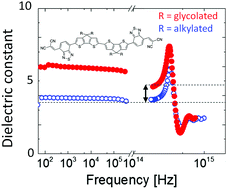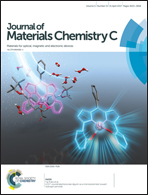Engineering dielectric constants in organic semiconductors†
Abstract
The dielectric properties of three pairs of organic semiconductors that contain increasing numbers of cyclopentadithiophene-co-benzothiadiazole moieties (monomer, dimer and polymer) were studied and compared. The materials in each pair differed in the nature of the ‘solubilizing groups’, which are either alkyl- or glycol-based. At low frequencies (<MHz), dielectric constants of up to ∼9 were obtained for the glycolated materials. In addition, the optical- (high-) frequency dielectric constants for the glycolated dimer and polymer were 4.6 and 4.2 respectively, which are the highest values reported thus far for non-ionic organic semiconductors. The external and internal quantum efficiencies (EQE and IQE) of homojunction (i.e., single component) solar cells comprising the dimer and polymer glycolated materials both showed measurable improvements at wavelengths close to their optical gap when compared with the alkylated equivalents. The improvement is suggestive of an increase in the charge generation efficiency, potentially facilitated by the high optical-frequency dielectric constant.



 Please wait while we load your content...
Please wait while we load your content...